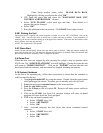8. Any signs of smoke or sparks which would indicate the potential for fire.
9. Any condition where the passenger was tampering with the system such as pounding on the fiberglass
or undue pressure on the cockpit.
2-15 Operational Restrictions
There are certain conditions that the machines should not be operated under. These conditions are
described below.
2-15A Intoxication
If a patron is under the influence of any drugs or alcohol they should not be allowed to utilize the
equipment.
2-15B Heart Conditions
Any heart or other similar condition would preclude a passenger from riding the simulator.
2-15C Pregnancy
It is not recommended that women who are pregnant ride the simulator.
2-15D Weight and Height Restrictions
The patrons must be at least 48” (1.22 m) tall and total weight is not to exceed 500 lb. (226.8 kg) with no
more than a 100 lb. (45.36 kg) difference between the passengers.
2-15E Electrical Storms
It is up to the discretion of the owner operator to operate during an electrical storm. However, it is NOT
recommended to rely on the internal facility safe guards to protect the equipment. When in doubt, shut
down the system to ensure safety of not only the passengers but also the safety of the system.
2-16 Daily Inspection Checklist Description
The Daily Checklist is to be completed by the first shift attendant operating the MT3000 as well as the
second shift attendant (if applicable) at the beginning of his/her shift. These sheets must be filled out on a
daily basis. DO NOT check off the items in the checklist unless you have performed the required
inspection. This maintenance is required to maintain optimum performance of the MT3000. The master
copy of this checklist can be found at the end of the Operator’s Manual.
CHAPTER 3 – SUGGESTED POSTINGS and
Manufacturer’s Specifications
3-1 Manufacturer’s Specifications
Reference Standard:
ASTM-F24 Standards on Amusement Rides and Devices
1. F583 Maintenance Procedures for Amusement Rides and Devices
2. F893 Inspection of Amusement Rides and Devices
3. F1159 Design and Manufacture of Amusement Rides and devices
MaxFlight, Corp., at the time of the initial design and prototype manufacture, determines by calculations
and testing the appropriateness of the functional design criteria. The visual esthetics of the ride are also
evaluated and together with the functional design criteria make up the manufacturer’s design specifications.
These design specifications are adhered to on all subsequently produced rides of the same style.
Occasionally, through field experience, it becomes necessary to specify a modification to the original
design specifications. Actual modification to meet the change in design specifications can only be


















